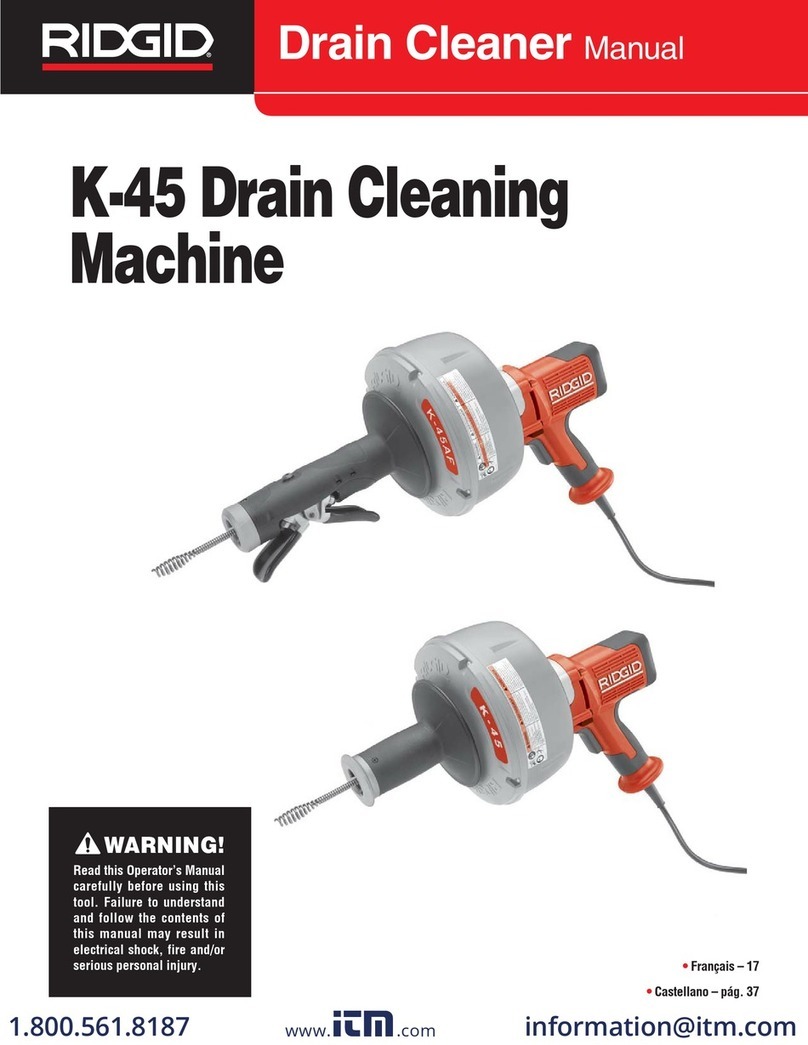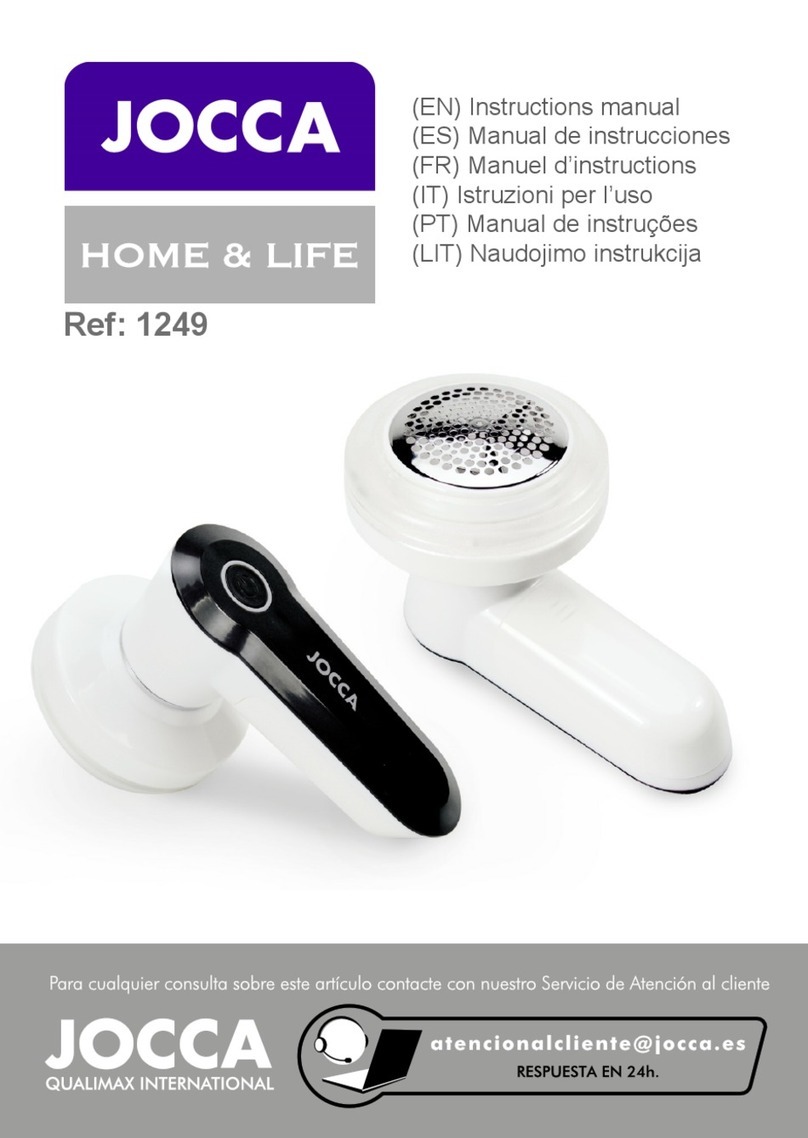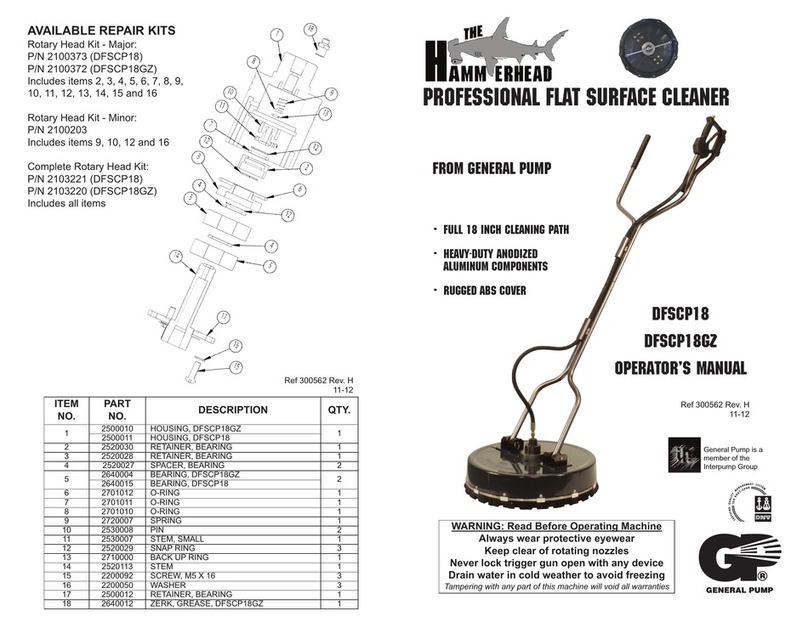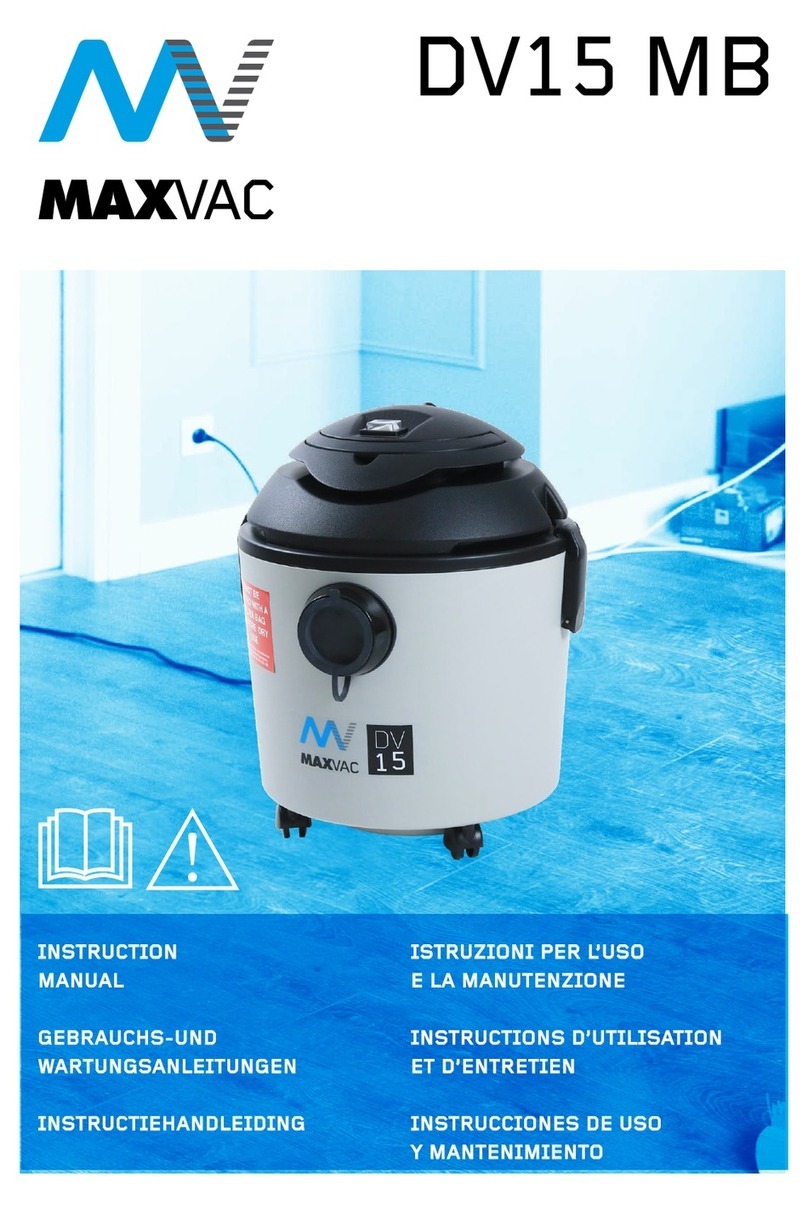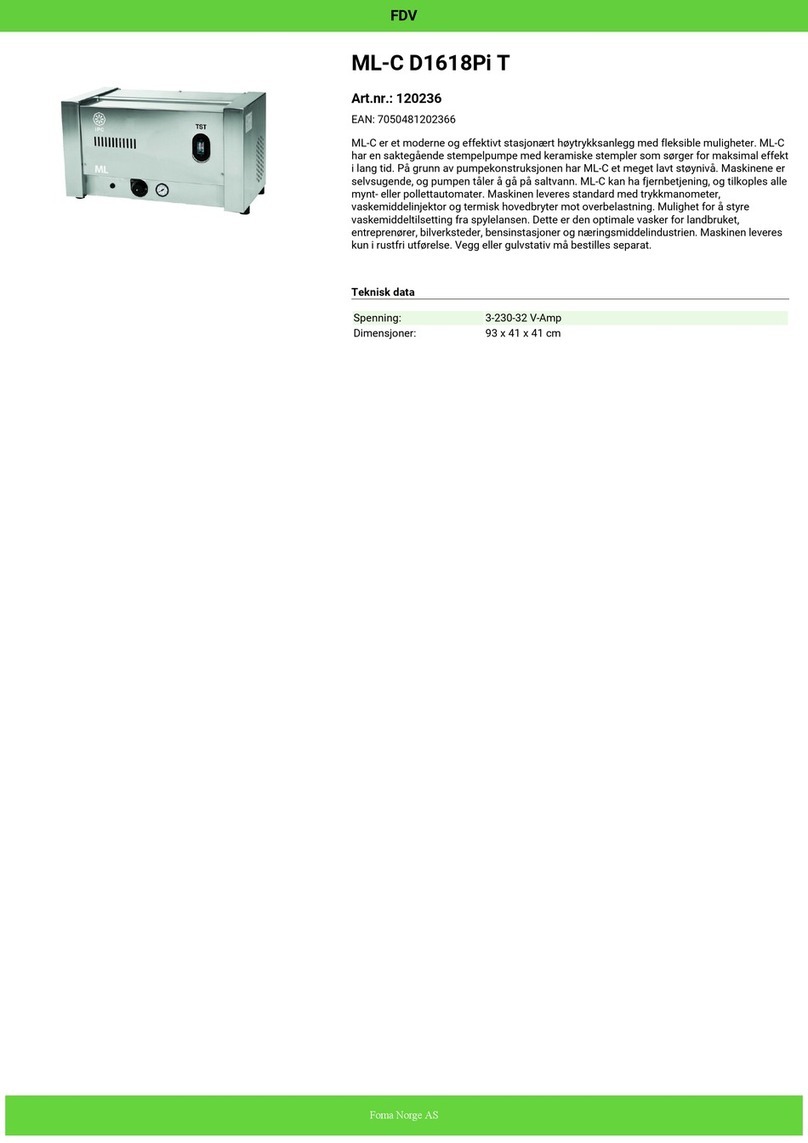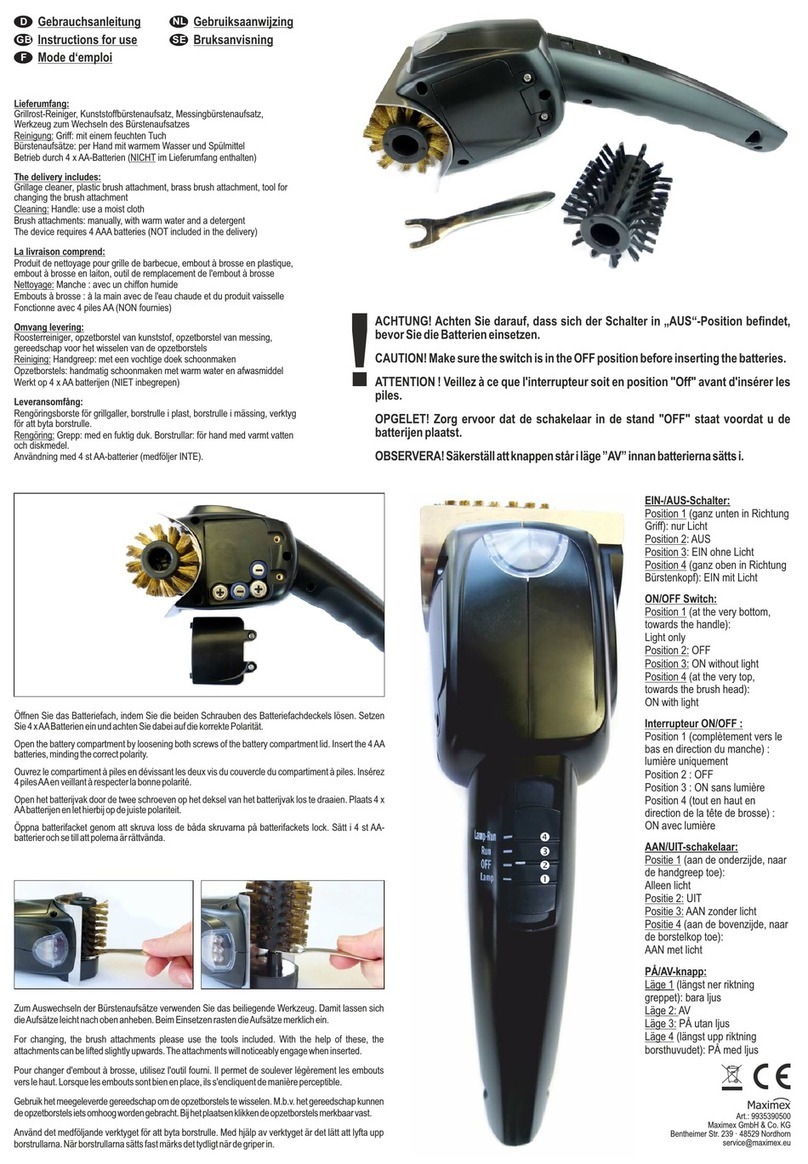Stark 45074 Original instruction manual

SAVE THIS MANUAL: KEEP THIS MANUAL FOR SAFETY WARNINGS, PRECAUTIONS, ASSEMBLY,
OPERATING, INSPECTION, MAINTENANCE AND CLEANING PROCEDURES. WRITE THE PRODUCT’S
SERIAL NUMBER ON THE BACK OF THE MANUAL NEAR THE ASSEMBLY DIAGRAM (OR MONTH
AND YEAR OF PURCHASE IF PRODUCT HAS NO NUMBER)
OWNER’S MANUAL AND SAFETY INSTRUCTIONS
FOR QUESTIONS PLEASE CALL OUR CUSTOMER SUPPORT: (909) 628 4900 MON-FRI 9AM TO 3PM PST
50’ 1/2” 250W ELECTRIC SEWER SNAKE DRAIN AUGER CLEANER
ITEM: 45074

GENERAL SAFETY WARNINGS
Read all safety warnings and instructions. Failure to follow the warnings and instructions may
result in electric shock, re and/or serious injury. Save all warnings and instructions for future
reference.
SAFETY
The warnings, precautions, and instructions discussed in this instruction manual cannot cover all possible
conditions and situations that may occur. It must be understood by the operator that common sense and
caution are factors which cannot be built into this product, but must be supplied by the operator. Read
carefully and understand all ASSEMBLY AND OPERATION INSTRUCTIONS before operating. Failure
to follow the safety rules and other basic safety precautions may result in serious personal injury.
Read and understand all instructions. Failure to follow all instructions may result in serious injury or
property damage.
DO NOT allow persons to operate or assemble the product until they have read this manual and have
developed a thorough understanding of how it works.
DO NOT modify this product in any way. Unauthorized modication may impair the function and/or
safety and could affect the life of the product. There are specic applications for which the product was
designed.
Keep children and bystanders away from the work area while operating the tool. DO NOT allow
children to handle the product.
Grounded tools must be plugged into an outlet that is properly installed and grounded in accordance
with all codes and ordinances. NEVER remove the grounding prong or modify the plug in any way.
Double insulated tools are equipped with a polarized plug. Double insulation eliminates the need for a
three wire grounded power cord and grounded power supply system.
Avoid body contact with grounded surfaces such as pipes, radiators, ranges and refrigerators. There is
an increased risk of electric shock if your body is grounded.
DO NOT expose power tools to rain or wet conditions. Water entering a power tool will increase the risk
of electric shock.
DO NOT abuse the cord. Never use the cord for carrying, pulling or unplugging the power tool. Keep
cord away from heat, oil, sharp edges or moving parts. Damaged or entangled cords increase the risk
of electric shock.
When operating this tool outdoors, use an extension cord marked with “W-A” or “W”. These extension
cords are rated for outdoor use and reduce the risk of electric shock.
If operating a power tool in a damp location is unavoidable, use a Ground Fault circuit Interrupter (GFcI)
protected supply.
1
DO NOT leave the tool unattended when it is plugged into an electrical outlet. Turn off the tool and unplug
it from its electrical outlet before leaving.
DO NOT Do not smoke during use. Nicotine reduces the blood supply to the hands and ngers, increasing
the risk of vibration-related injury.
IMPORTANT SAFETY INFORMATION

Stay alert, watch what you are doing and use common sense when operating this tool. DO NOT use
a power tool while you are tired or under the inuence of drugs, alcohol or medication. A moment of
inattention while operating power tools may result in serious personal injury.
Prevent unintentional starting. Ensure the Switch is in the off-position before connecting to power source,
picking up or carrying the tool. Carrying power tools with your nger on the Switch or energizing power
tools that have the Switch on invites accidents.
Use personal protective equipment. Always wear eye protection. Safety equipment such as dust mask,
non-skid safety shoes, hard hat, or hearing protection used for appropriate conditions will reduce personal
injuries.
DO NOT overreach. Keep proper footing and balance at all times. This enables better control of the
power tool in unexpected situations.
Remove any adjusting key or wrench before turning the tool on. A wrench or a key left attached may
result in personal injury.
Only use safety equipment that has been approved by an appropriate standards agency.
Unapproved safety equipment may not provide adequate protection. Eye protection must be ANSI-
approved and breathing protection must be NIOSH-approved for the specic hazards in the work area.
DO NOT use the power tool if the Switch does not turn it on and off. Any power tool that cannot be
controlled with the Switch is dangerous and must be repaired.
Disconnect the plug from the power source before making any adjustments, changing accessories, or
storing power tools. Such preventive safety measures reduce the risk of starting the power tool accidentally.
2
Store idle power tools out of the reach of children and do not allow persons unfamiliar with the power tool
or these instructions to operate the power tool. Power tools are dangerous in the hands of untrained user.
Maintain power tools. check for misalignment or binding of moving parts, breakage of parts and any other
condition that may affect the power tool’s operation. If damaged, have the power tool repaired before use.
Many accidents are caused by poorly maintained power tools.
Use the power tool, accessories and tool bits etc. in accordance with these instructions, taking into account
the working conditions and the work to be performed. Use of the power tool for operations different from
those intended could result in a hazardous situation.
DO NOT allow the cutter to stop turning while the machine is runnng. This provides better control of the
cable and helps to prevent twisting.
Keep a gloved hand on the cable whenever the machine is running.
Install this product on a solid, at surface that is capable to support the weight of the Drain cleaner.
DO NOT put too much stress on the cable. In the course of drain cleaning, if the cable encounters an
obstruction, it may stress the cable and cause the cable to twist and kink or break. This may result in
personal injury or damaged equipment or pipes.
Position the drain cleaner within two feet of the drain opening.
One person must control both the cable and the foot switch.
Reverse motor direction only whne pulling the cable out of the pipe or obstruction. Make sure the drum has
stopped turning before changing the power switch.
Keep hands away from rotating drum and distributor tube. Do not reach into the drum if the power is on.
Avoid electric shock. DO NOT operate this tool if the operator or machine is standing in water.
WARNING: People with pace makers should consult their physician before using the product.
IMPORTANT SAFETY INFORMATION

3
Be aware of possible damage to the drain lines that may result from the discovery of roots and obstacles.
To prevent electric shock and death from incorrect grounding wire connection. Check with
a qualied electrician if you are in doubt as to whether an outlet is properly grounded.
3-Prong
Plug and
Outlet
1. Tools marked with “Grounding Required” have a three wire cord and three
prong grounding plug. The plug must be connected to a properly grounded
outlet. If the tool should malfunction or break down, grounding provides a low
resistance path to carry electricity away from the user, reducing the risk electric
shock.
2. The grounding prong in the plug is connected through the green wire inside
the cord must be the only wire cinnected to the tool’s grounding system and
must NEVER be attached to an electrically “live” terminal.
Ground Fault Circuit Interrupter (GFCI)
Your machine is equipped with a GFCI, which protects against electric shock if a short circuit should occur.
Check that the receptacle is properly grounded and test the GFCI before each use.
1. Plug the GFCI power plug into a grounded receptacle.
2. Press the “TEST” button. The GFCI indicator light will go out and power to the machineshould cut off.
3. WARNING: If the light does not go out when the TEST button is depressed. Equipment should not be used
until proper repairs have been made by a qualied technician.
4. To restore power after testing, push the reset button. WARNING: If the machine doesn’t start, stops while
running or if you experience a mild shock, DO NOT use the machine. Have it repaired by a technician.
NOTE: The power cord is NOT GFCI protected from the GFCI unit to the 3-prong plug in the outlet.
Extension Cords
1. Grounded tools require a three wire extension cord. Double insulated tools can use either a two or three
wire extension cord.
2. As the distance from the supply outlet increases, you must use a heavier gauge extension cord. Using
an inadequately sized wire causes a serious drop in voltage, resulting in a loss of power and possible tool
damage.
3. The smaller the gauge number of the wire, the greater the capacity of the cord. For example, a 14 gauge
cord can carry a higher currentthan a 16 gauge cord. See Table A
4. If the extension cord is being used for more than one tool, add the nameplate amperes and use the sum
to determine the required minimum cor size.
TABLE A
* Based on limiting the line Voltage dropped to ve volts at 150% of the rated armperes.
ELECTRICAL SAFETY INFORMATION

4
SEALED
AIR FOOT
SWITCH
ROTATION SWITCH
BELT GAURD
TENSION KNOB
POWER FEED LEVER
FRAME
HANDLE LOCKING KNOBS
TOOL TRAY
DRUM
CABLE
WHEEL
BELT
GAURD
KNOB
This Portable Drain Cleaning Machines clears lines from 1” to 4”. Easily drive and retract the 1/2” cable
using the automatic power feed system. Feel safe knowing the 110 volt plug and air operated foot switch
can be operated with water on the oor in kitchens and bathrooms. It includes 50’ of 1/2” cable and a 4 piece
cutter kit to clear most drain lines.
FEATURES
Assembled Product Dimensions
(L x W x H): 23.00 x 17.50 x 36.00 Inches
50’ x 1/2” Cable and Universal Slotted 4
piece cutter kit
Portable 8” Solid Rubber Tires and 5”
steel wheels
13” x 6” Quick Release Belt Driven Drum
250 watt 110 volt forward/reverse motor
5’ GCI Power Cord with 3 pronged ground
4’ Air operated foot switch
60 HZ 2.7 amp 1400 rpm electric motor
Measures: 36” tall (30” without handle) x
17.5” wide x 23” deep 1” Square Metal Frame with Rubber feet
Metal tool box attached for tools
CUTTING TOOL ACCESSORIES
There are four cutting tools included with the Drain Cleaner. Select the appropriate tool for the cleaning
job and attach to the cable. Each is described in the table below.
ARROW
CUTTER
BULB
CUTTER
C-CUTTER SPADE
CUTTER
PRODUCT INFORMATION

5
NOTICE: If the cause of the obstruction is unknown, use the bulb cutter to explore the obstruction. If
possible, retreive a piece to inspect. Once you can see the cause of the obstruction, select the appropriate
tool for the job. Run the smallest available tool through the blockage to allow the backed up water to ow
and carry away the debris as the drain is cleaned. Once the drain is owing, more appropriate tools can
be used on the rest of the blockage. Keep in mind that the largest tool used should be no bigger than the
drain’s diameter, minus an inch.
If properly used, the drain cleaners and assorted drain cleaner accessories will not damage a drain that
is in good condition and properly designed, constructed and maintained. However, if the drain is in poor
condition or has not been properly designed, the drain cleaning work may damage the drain. Before
operation visually inspect the drain’s quality.
ASSEMBLY

6
WARNING: Before each use, inspect the drain cleaner and correct any problems to reduce risk of serious
injury from electric shock, twisted or broken cables, chemical burns, infections and other causes and
prevent drain cleaner damage.
WARNING: Read and adhere to the following guidelines to prevent serious personal injury and property
damage. ALWAYS wear ANSI approved goggles, hork gloves and appropriate equipment when setting
up your drain cleaner. For extra protection from chemicals and bacteria on the machine and in the work
area, we recommend wearing latex, rubber or other liquid barrier gloves under the heavy-duty work
gloves. Before use, inspect the gloves to be sure they are free of defects or loose sections that could be
caught in the drain cleaner. Rubber soled, non-slip shoes can help prevent slipping and electric shock,
especially on wet surfaces.
1. Once the drain cleaner is assembled, check that the device and cutters have no signs of wear or
damage. If necessary, replace worn or damaged parts prior to using this product.
2. Verify the drain cleaner is unplugged and inspect the power cord, GFCI and plug for damage. If the
plug has been modied or is missing the grounding prong or the cord is damaged, DO NOT use the
machine until the cord has been repaired by a qualied electrician.
3. Clean any oil, grease or dirt from all equipment handles and controls. This helps prevent the machine
or control from slipping during use.
4. Verify the foot switch is attached to the drain cleaner.
5. Verify the drain cleaner is properly assembled. Inspect the machine for broken or damaged parts
before every use.
6. Make sure switches and handles move smoothly between positions and lock into place and that the
bumpers at the bottom of the handle are present and rmly attached.
7. Rotate the drum and make sure that it turns freely without binding.
8. Check that all warning lables are present and rmly attached to the machine.
9. Make sure the belt gaurd is securely fastened to the drain cleaner.
10. Check the cable for any wear or damage. If any part of the cable is attened or damaged, repair it
before using the machine.
11. Verify the cable does not have multiple kinks. Kinks weaken the cable and can cause cable failure.
replace them before using the machine.
12. Look for spaces between the cable coils. Kinking, stretching or running the cable in reverse can
deform the cable. Cables with spaces between the coils should be replaced.
13. Check for signs of excessive corrosion. Corrosion weakens the cable, making it brittle. This can be
caused by storing the cable wet or using the cable with corrosive chemicals (often found in chemical clog
removers). Excessively corroded cable should be replaced.
14. Before use, fully retract the cable with no more than 2” of cable outside of the machine. This will keep
the cable from whipping when machine is turned on.
15. Set the power switch to the OFF position.
16. With dry hands, plug the cord into a properly grounded outlet and move the power switch to the
FORWARD position.
17. Move the feed lever to exactly between the Fand Rsettings, otherwise the cable will start moving in
or out during this test.
SET UP

7
18. Press the foot switch and note the direction of rotation of the drum. if the foot switch does not control the
cleaner’s operation, DO NOT use the machine until the foot switch has been repaired.
19. The drum should rotate clockwise when seen from the front of the drum. It wil match the drum direction
shown on the warning label and the arrows molded onto the drum.
20. release the foot switch and let the drum come to a complete stop. Place the switch into the reverse
position and test the operation again to make sure the drain cleaner operates poroperly in reverse. if the
rotation is not correct, DO NOT use the machine until it has been repaired.
21. After inspection, set the power switch to OFF and unplug the drain cleaner.
22. Once you’ve veried the drain cleaner is in good working order, inspect the work area where you will be
using the machine.
WORK AREA SET UP
1. Verify the work area has adequate lighting for the job.
2. Make sure the work area is free of ammable liquids, vapors or dust that may ignite. Sparks can be
generated during drain cleaner operation.
3. Verify the electrical outlet is properly grounded. A three oring or GFCI outlet may not be properly grounded.
If in doubt, have the outlet inspected by a licensed technician.
4. Make sure there is a clear and unobstructed path from the drain cleaner to the electrical outlet.
5. Inspect the drain to be cleaned. If possible, determine the best access point to the drain, the size and
length of the drain, distance to tank mainlines, the nature of the blockage and/or presence of drain cleaning
chemicals.
6. If there are chemicals present in the drain, read and adhere to the specic safety measures required to
work around the chemicals.
7. If necessary, remove the xture to allow access to the drain. DO NOT feed a cable through the xture.
Doing so may cause damage to the drain and/or xture.
8. Determine the correct drain cleaning cable size for the job. See the Cable/Pipe Size Chart below for more
information.
9. Make sure the drain cleaner handle is locked into the upright position for transport. If the drain cleaner
needs to be lifted, use proper lifting techniques.
10. Set the drain cleaner so that the drum opening is within two feet of the drain access. The greater the
distance from drain access, the higher the risk of the cable twisting or kinking.
11. If the machine cannot be placed with the drum opening within 2” of the drain access, use appropriate
sized pipes and ttings to extend the drain access back to within 2” of the drum opening. Improper cable
support can cause the cable to kink and twist and can damage the cable or injure the operator.
12. If needed, set up barriers to keep bystanders away from the drain cleaner and work area during operation.
13. Select the proper cutting tool.
SET UP

8
14. Verify the electrical outlet is properly grounded. A three oring or GFCI outlet may not be properly grounded.
If in doubt, have the outlet inspected by a licensed technician. Install the tool to the end of the cable. Slide
the base of the cutter tool into the slot at the end of the cable. Fasten together using a screwdriver.
15. Postion the foot switch for easy accessibility. You must be able to hold and control the cable, control the
foot switch and reach the power switch.
16. Conrm that the power switch is in the OFF position.
17. Run the cord along the clear path. With dry hands, plug the drain cleaner into a properly grounded outlet.
18. If the power cord is not long enough, use an extension cord that is in good condition and has a three
prong plug similar to the one supplied on the drain cleaner. Keep the connection off the ground to prevent
it from getting wet.
WORKING THROUGH A BLOCKAGE
1. If the cutting tool becomes lodged in blockage and drain cleaner is still operating, the cable will start to
wind up or twist. If this happens, oull back on the cable to free the cutting too from the blockage.
WARNING: DO NOT keep the cable rotating if the tool is lodged in a blockage. If the tool stops turning and
the drum still rotates, the cable can twist, kink or break.
2. Once the tool is free of blockage and is turning again, slowly feed rotating cutting tool back into the
vlockage. Do not force the tool through blockage.
3. Allow the spinning and cutting to break up and work the blockage. CAUTION: While working the blockage,
the tool and cable can get clogged with debris and cuttings from blockage, preventing further cleaning. The
cable tool will then need to be retreived from the drain and the debris removed.
HANDLING LODGED CUTTING TOOL
1. If the cutting tool stops turning and the cable cannot be pulled from the blockage, release the foot switch
while holding the cable with both hands.
WARNING: DO NOT remove hands from the cable or the cable may kink, twist and break.
2. The drain cleaner motor will stop and the cable and drum will turn backwards until tension in the cable is
released.
WARNING: DO NOT remove hands from the cable until all the tension is released.
3. Place the power switch in the OFF position.
FREEING A LODGED CUTTING TOOL
1. Release the foot switch and turn the power switch to the off position.
3. Hold the cable with both hands, press the foot switch for several seconds and pull on the cable until it is
free of the blockage.
WARNING: DO NOT operate the drain cleaner in reverse for any longer than is needed to be free the
cutting tool from blockage.
4. Place the pwer switch in the forward position and continue cleaning the drain.
2. Pull the cable loose from the blockage. if the tool will not come free, place the power switch in reverse
position.
SET UP

9
RETREIVING DRAIN CLEANER CABLE
1. Once the drain is clear, turn on the faucet or use a hose to ush the debris out.
NOTE: Pay attention to the water level. There could be blockages further down the drain.
2. Set the power switch to the OFF position and unplug the machine.
3. Pull the cable from the drain by hand and feed into the drain cleaner. The ow of water down the line will
helo ti clean the cable as it is retreived. if necessary, change the cutting tool and cintinue cleaning.
WARNING: DO NOT pull the cable from the drain while the cable is still rotating. Cable can whip around,
causing serious injury.
RETREIVING DRAIN CLEANER CABLE
1. Position the drain cleaner two feet from the drain.
2. Release all tension from the tension knob then grab the cable with
both hands and push the cable until at least one foot of cable is in the
drain. Retighten tension knob.
TENSION KNOB
POWER FEED
LEVER
3. After making sure the power switch is in the FORWARD position, the
feed knob has been retightened and the power feed lever is in the down
position, press the foot switch and start feeding the cable further into the
drain. Make sure you can operate the foot switch while have at least one
hand on the cable at all times. Make sure the power switch on top of the
drain cleaner and power feed lever are within reach.
WARNING: Only one person should operate the cable feed and the foot
switch. this can cause the cable to kink and break.
4. If the cable become lodged in a narrow part of the drain or in a drain trap, put the power feed lever in the
NEUTRAL position and allow the cable to try and work itself past the obstruction. If the cable still won’t pass
the obstruction, release pressure from the foot switch and use sharp downward thrusts to try and free the
cable. Once the cable is free, put the power feed lever in the down (forward position, put pressure back on
the foot switch and continue feeding.
WORKING THROUGH A BLOCKAGE
1. If the cutting tool becomes lodged in a blockage and drain cleaner is still operating, the cable will start to
wind up or twist. If so, release pressure from the foot switch and the drain cleaner motor will stop.
WARNING: DO NOT let the cable build up outside the drain. The cable drum will turn backwards until the
tension in the cable is released.
WARNING: DO NOT remove your hand from the cable until the tension is released.
2. Put the power feed lever in REVERSE position to pull the cable back and free the cutting tool from the
blockage.
3. If the motor can’t pull the cable out, release pressure from the foot switch and allow the cable to stop
spinning. Once the cable stops spinning, grab the cable with both hands and pull the cable free.
4. Once the tool is free of blockage and is turning again, slowly feed the cutting tool back into the blockage.
DO NOT force the tool through blockage. Allow the cutting tip to break up and work through the blockage.
CAUTION: While working blockage, the tool and cable can get clogged, preventing further cleaning. The
cable tool will need to be retreived from the drain and debris removed.
OPERATION

10
CLEANING DRAIN CLEANER CABLES
1. Thoroughly ush the drain cleaner cables with clean water after every use.
Turn the power switch OFF and unplug the drain cleaner before performing any
maintenance.
ALWAYS wear safety goggles and gloves while performing any maintenance.
2. Once cables have been ushed, carefully tip the drain cleaner forward to empty out any remaining debris.
3. Once the cable is clean and dry, pull the cable from the drum.
4. Lubricate with an oily rag as you feed the cable back into the drum.
WARNING: DO NOT attempt to remove a rotating cable.
CLEANING AND LUBRICATING HOUSING
1. The drain cleaner should be cleaned as needed with hot soapy water and/or disinfectants.
2. Dry the drain cleaner before storing or using again.
3. Once dry, thoroughly lubricate with a lightweight machine oil.
4. If the drain cleaner drum os removed or changed, grease the bearings with general purpose grease.
WARNING: Risk of shock! DO NOT allow water to get into the motor or any other electrical components.
REMOVING AND INSTALLING THE BELT
1. Loosen the belt gaurd knob and slide belt gaurd off from the top of the clenaer’s motor.
2. Use a screwdriver to slide the belt off the back of the cleaner’s drum.
3. Slide a new belt into the belt pulley above the drum.
4. Slide the new belt onto the rear of the drum until securely in place.
SPECIFICATIONS
MAINTENANCE

11
TROUBLESOOTING

12
PARTS

THE MANUFACTURER AND/OR DISTRIBUTOR HAS PROVIDED THE PARTS LIST AND ASSEMBLY
DIAGRAM IN THIS MANUAL AS A REFERENCE TOOL ONLY. NEITHER THE MANUFACTURER OR
DISTRIBUTOR MAKES ANY REPRESENTATION OR WARRANTY OF ANY KIND TO THE BUYER THAT
HE OR SHE IS QUALIFIED TO MAKE ANY REPAIRS TO THE PRODUCT, OR THAT HE OR SHE IS
QUALIFIED TO REPLACE ANY PARTS OF THE PRODUCT. IN FACT, THE MANUFACTURER AND/OR
DISTRIBUTOR EXPRESSLY STATES THAT ALL REPAIRS AND PARTS REPLACEMENTS SHOULD BE
UNDERTAKEN BY CERTIFIED AND LICENSED TECHNICIANS, AND NOT BY THE BUYER. THE BUYER
ASSUMES ALL RISK AND LIABILITY ARISING OUT OF HIS OR HER REPAIRS TO THE ORIGINAL
PRODUCT OR REPLACEMENT PARTS THERETO, OR ARISING OUT OF HIS OR HER INSTALLATION
OF REPLACEMENT PARTS THERETO.
Record Product’s Serial Number Here:
Note: If product has no serial number, record month and year of purchase instead.
Note: Some parts are listed and shown for illustration purposes only and are not available individually
as replacement parts.
PLEASE READ THE FOLLOWING CAREFULLY
13
WARRANTY
PRODUCT MADE IN CHINA
Table of contents


